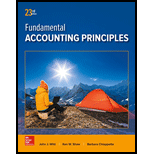
Concept explainers
Concept Introduction:
Periodic Inventory System: The periodic inventory system records and updates the inventory at the end of a particular period. The inventory balance is not updated after each transaction and it is updated periodically.
Methods of
• Specific identification method: Under this method the cost of goods sold and ending inventory units are identifiable and the cost is calculated accurately for each unit sold and in the inventory.
• Weighted Average method: Under this method, the cost per unit of the inventory is calculated as weighted average cost per unit and the cost of goods sold and inventory is calculated with the help of weighted average cost per unit.
• FIFO method: FIFO Stands for First In First Out. Under this method, the units purchased first are assumed to be sold first and cost of goods sold is calculated accordingly. The ending inventory in the method includes the latest units purchased.
• LIFO method: LIFO Stands for Last In First Out. Under this method, the latest units purchased are assumed to be sold first and cost of goods sold is calculated accordingly. The ending inventory in the method includes the oldest units purchased.
Requirement-(a):
To determine: The cost of goods sold and gross margin using the Specific Identification inventory method:
Requirement-(b):
To determine: The gross margin using the Specific Identification inventory method:
Want to see the full answer?
Check out a sample textbook solution
Chapter 6 Solutions
Fundamental Accounting Principles
- Quick answer of this accounting questionsarrow_forwardHelparrow_forwardKate Corporation owns a patent on an automated system. The company has been amortizing the patent on a straight-line basis since 2013, when it was acquired at a cost of $60 million at the beginning of that year. Due to technological advancements, management has now decided that the patent will benefit the company for a total of five years instead of the original ten-year amortization period. This decision was made at the end of 2016 (before adjusting and closing entries). What is the appropriate 2016 amortization expense for the patent?arrow_forward
- Calculate the Operating Cash Flow (OCF) from the following data: • Change in net fixed assets: $25,000 • Change in net working capital: $30,000 • Dividends Paid: $35,000 Depreciation Expense: $40,000 • Interest Paid: $22,000 • Net New Borrowing: $18,000 • Net New Equity Issued: $12,000arrow_forwardA machine costing $92,500 with a 9-year life and $88,200 depreciable cost was purchased on January 1. Compute the yearly depreciation expense using straight-line depreciation. Round the answer to the nearest whole dollar.arrow_forwardWhat are the beginning and ending amounts of equity on these financial accounting question?arrow_forward
- General accounting questionarrow_forwardSeveral years ago, a parent company acquired all of the outstanding common stock of its subsidiary for a purchase price of $320,000. On the acquisition date, this purchase price was $75,000 more than the subsidiary's book value of Stockholders' Equity. The AAP was entirely attributable to Goodwill. On the date of acquisition, the parent company's management believed that the goodwill had a 10-year useful life. Since the date of acquisition, the subsidiary has reported a cumulative net income of $260,000 and paid $105,000 in dividends to its parent company. Compute the balance of the Equity Investment account on the parent's balance sheet, assuming that the Goodwill asset has not declined in value since the date of acquisition.arrow_forwardCompute the amount of maintenance department expensearrow_forward

 AccountingAccountingISBN:9781337272094Author:WARREN, Carl S., Reeve, James M., Duchac, Jonathan E.Publisher:Cengage Learning,
AccountingAccountingISBN:9781337272094Author:WARREN, Carl S., Reeve, James M., Duchac, Jonathan E.Publisher:Cengage Learning, Accounting Information SystemsAccountingISBN:9781337619202Author:Hall, James A.Publisher:Cengage Learning,
Accounting Information SystemsAccountingISBN:9781337619202Author:Hall, James A.Publisher:Cengage Learning, Horngren's Cost Accounting: A Managerial Emphasis...AccountingISBN:9780134475585Author:Srikant M. Datar, Madhav V. RajanPublisher:PEARSON
Horngren's Cost Accounting: A Managerial Emphasis...AccountingISBN:9780134475585Author:Srikant M. Datar, Madhav V. RajanPublisher:PEARSON Intermediate AccountingAccountingISBN:9781259722660Author:J. David Spiceland, Mark W. Nelson, Wayne M ThomasPublisher:McGraw-Hill Education
Intermediate AccountingAccountingISBN:9781259722660Author:J. David Spiceland, Mark W. Nelson, Wayne M ThomasPublisher:McGraw-Hill Education Financial and Managerial AccountingAccountingISBN:9781259726705Author:John J Wild, Ken W. Shaw, Barbara Chiappetta Fundamental Accounting PrinciplesPublisher:McGraw-Hill Education
Financial and Managerial AccountingAccountingISBN:9781259726705Author:John J Wild, Ken W. Shaw, Barbara Chiappetta Fundamental Accounting PrinciplesPublisher:McGraw-Hill Education





